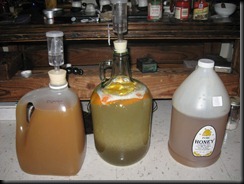People talk about the old Grimoires and books of magic having “blinds”–instructions left out, or added, to botch attempts by the uninitiated. This may or may not be true, but I have become convinced that many mead-making recipes DO include such blinds, and I think it’s fucking bullshit. Below is my method. If your recipe calls for something more complex, think twice. If something looks stupid, it probably is. If someone tells you that it’s too hard, or too expensive, or too messy to do yourself … they want into your wallet, or into your pants. Maybe both.
I’ve been meaning to write this up anyway, to streamline the recipes I post. It has been made critical by an unfortunate accident in a good friend’s first attempt at mead-brewing. I don’t know where she got it, honestly I don’t want to: I’d have to flame the shit out of their comments section, and maybe even put in a bad word for them with Him Who Watches Over My Homebrew.
I’ll update this with pictures the next time I start a batch. In the meantime: knowing is half the battle.*
Satyr Magos’ Process For Turning Honey, Water, Yeast, and Misclanea Into Damn Fine Mead
My process is mind-bogglingly simple. In fact, most of the time I skip half these steps. This process has thus far worked for every recipe I’ve tried in my almost three years of homebrewing.
1. (Optional) Start with my honey, and mix it 1:2 with water in a big pot on the stove. Don’t boil it, just get it hot enough that a light foam begins to rise to the surface. That foam is wax and other impurities–skim it off. In addition to purifying the honey, this step offers an opportunity get the most out of ingredients that will benefit from the heat+water combination (herbs &c.). Put a lid on your pot and let it cool to the point where it’s safe to either either suck-start your siphon or pick up the pot with your hands. Move on to step 2 while you wait.
2. Pour your yeast into a container of orange juice (whatever quantity is appropriate for the recipie you are using). Let this sit to the side while you work. By the time you’re ready to add this to the mix, it should be happy and frothy.
3. Pour your honey+water mixture into your carboy in whatever way is most convenient. (If you skipped step 1, start by putting about 2x your volume of honey in the carboy first. Use warm water, and mix the honey in as you add it.) I like to use my racking hose and/or a funnel.
4. Add your initial flavoring elements (any that did not get added in step 1.)–that is, all the ingredients other than the water, honey, and yeast. Mix this up well. For a one gallon batch, I cap the bottle and shake it vigorously. For a five gallon batch, I grab the bottle by the top and rock it in circles along the circumference of the base (this is less complicated than it sounds: wobble it in a circular fashion).
5. (Optional) Add enough water to bring the carboy up to 2/3 full. Mix well.
6. Add the yeast. Mix welll.
7. Add enough water to almost fill the carboy, but leave an inch or two of space at the top for the must to get frothy. You can top it off the rest of the way when the initial fermentation (the frothing) is finished. Mix well.
8. Apply air-lock. Leave in warm (60-80 deg. F, depending on your yeast) dark place.
9. (Optional, but gets better results) Mix daily for the first week. Rack at 1-3 weeks, at 6 weeks, at 13 weeks, and as needed thereafter. Add flavoring elements as needed, as whim takes you, or as recipe directs.
10. (Optional for 1-gallon batches) Bottle any time after 6 months (3 months for fast-brewing Small Mead recipes), or as recipe directs.
12. Toast Dionysus.
13. Drink Copiously.
* Why, yes, I am a child of the 1980s. Why do you ask?



